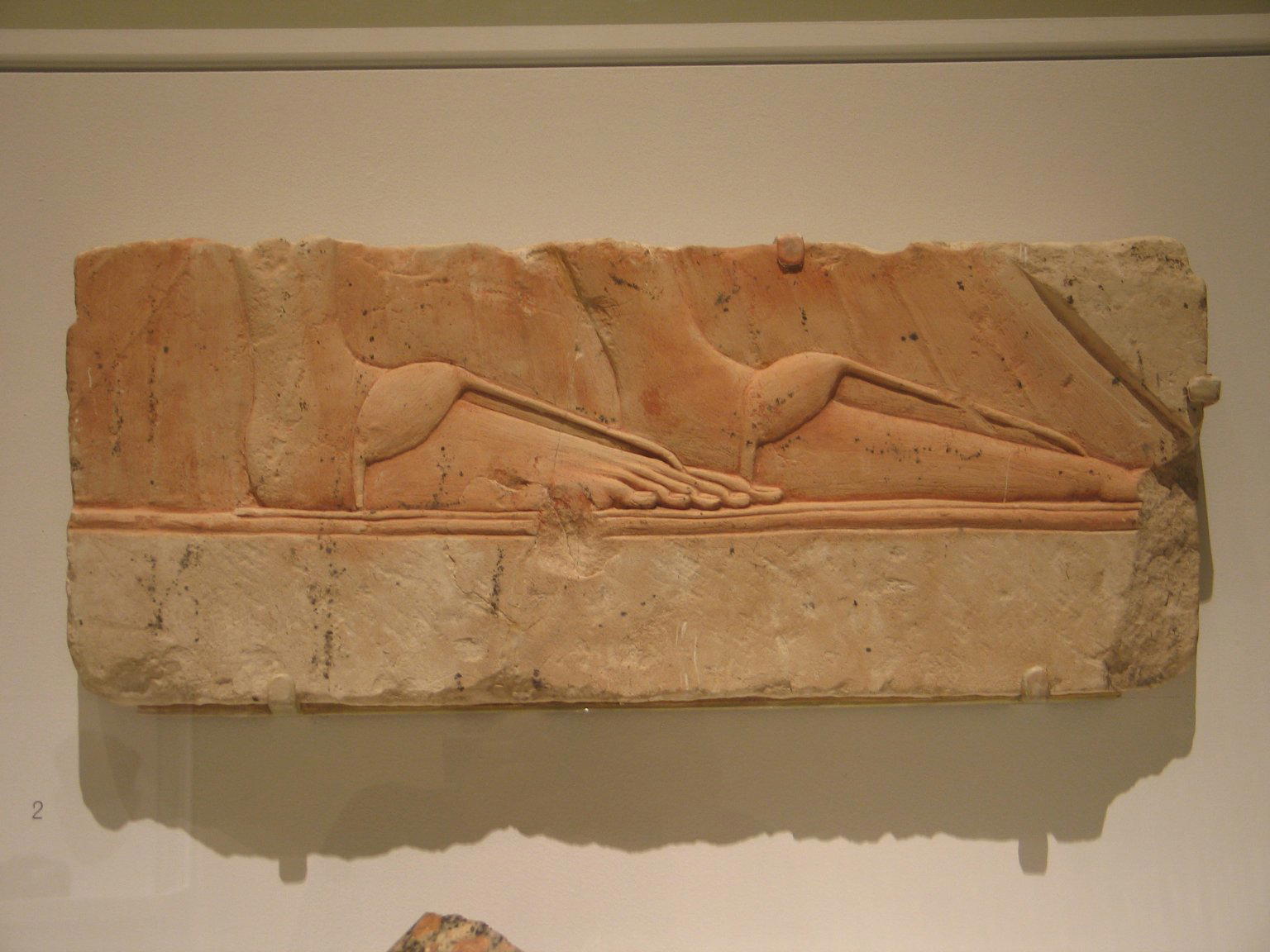Relief of Sandaled Feet of a Royal Woman
1352–1332 B.C.E.
1 of 7
Object Label
Traditional Egyptian relief rendered both feet as seen from the inside, with the big toe closer to the viewer. In the Eighteenth Dynasty, however, artists began to experiment with more accurate representations, first in tomb painting and then in sculpture and relief. This relief, representing all five toes of the right foot, is one of the first examples of a break with the earlier tradition.
The standardized shape of the block and the realistic modeling are characteristic of the Amarna period. While several royal women of Amarna wore floor-length pleated garments like these, the life-size scale points to Queen Nefertiti as the owner of these feet.
The standardized shape of the block and the realistic modeling are characteristic of the Amarna period. While several royal women of Amarna wore floor-length pleated garments like these, the life-size scale points to Queen Nefertiti as the owner of these feet.
Caption
Relief of Sandaled Feet of a Royal Woman, 1352–1332 B.C.E.. Limestone, pigment, 8 7/8 x 21 3/4 in. (22.6 x 55.3 cm). Brooklyn Museum, Charles Edwin Wilbour Fund, 60.197.7. (Photo: Brooklyn Museum)
Title
Relief of Sandaled Feet of a Royal Woman
Date
1352–1332 B.C.E.
Dynasty
late Dynasty 18
Period
New Kingdom, Amarna Period
Geography
Place made: Tell el-Amarna, Egypt, Place excavated: Hermopolis Magna (Al-Ashmunayn), Egypt
Medium
Limestone, pigment
Classification
Dimensions
8 7/8 x 21 3/4 in. (22.6 x 55.3 cm)
Credit Line
Charles Edwin Wilbour Fund
Accession Number
60.197.7
Frequent Art Questions
What is the cultural significance of the "Relief of Sandaled Feet of a Royal Woman"?
The cultural significance comes in more with the whole image. This is only a fragment of a relief that would have shown the whole body. Based on the life-sized scale and the lines behind her feet that indicate a long, fine garment, the figure would have likely been that of Queen Nefertiti. So, during the reign of her husband, Akhenaten, this image would have been significant as an image of the reigning queen who had both political and religious power. As you may know, Akhenaten changed the official religion in Egypt and his changes were abandoned and even erased after his death. Many images of Nefertiti suffered as well. Her image would have been a reminder of "the heretic king."Thank you!Why are the feet like this during the Amarna period?
 What's unique about these feet is that they are depicted like real feet, a right and a left. In most ancient Egyptian art people are painted with two of the same feet, so you always see the inside of the foot because they thought that was the most characteristic view of the foot.In the Amarna period, artists in royal workshops showed a new interest in more realistic representations rather than just "hieroglyph" views of the body. It's because of the presence of all five toes and the long pleated dress in the background that we know these feet belong to a royal woman from this time, likely Nefertiti.Thank you!
What's unique about these feet is that they are depicted like real feet, a right and a left. In most ancient Egyptian art people are painted with two of the same feet, so you always see the inside of the foot because they thought that was the most characteristic view of the foot.In the Amarna period, artists in royal workshops showed a new interest in more realistic representations rather than just "hieroglyph" views of the body. It's because of the presence of all five toes and the long pleated dress in the background that we know these feet belong to a royal woman from this time, likely Nefertiti.Thank you!Why do the feet in the “Relief of Akhty-hotep” show only the arches?
Akhty-hotep's two left feet were a common feature of ancient Egyptian art. The ancient Egyptians were more interested in completeness and communication rather than realism.Ancient Egyptians felt that this angle, showing the arch, was the most descriptive angle to show a foot and therefore rendered all two dimensional feet in this way.If you take a look at the "Royal Feet" in the Amarna Period gallery, you'll notice that the royal woman is shown with two different feet, a unique feature of art during that time period.Tell me more.
 These feet are remarkable in ancient Egyptian art. It was typical to show people (in two dimensions) with two of the same foot rather than two different feet like we see here. This unique detail was something only applied to royal figures during the Amarna Period.Interestingly, this block was not found at the city of Amarna though. It was found across the Nile at Hermopolis where it had been taken to be reused in temple construction under Ramesses II (the Great).
These feet are remarkable in ancient Egyptian art. It was typical to show people (in two dimensions) with two of the same foot rather than two different feet like we see here. This unique detail was something only applied to royal figures during the Amarna Period.Interestingly, this block was not found at the city of Amarna though. It was found across the Nile at Hermopolis where it had been taken to be reused in temple construction under Ramesses II (the Great).
Have information?
Have information about an artwork? Contact us at






